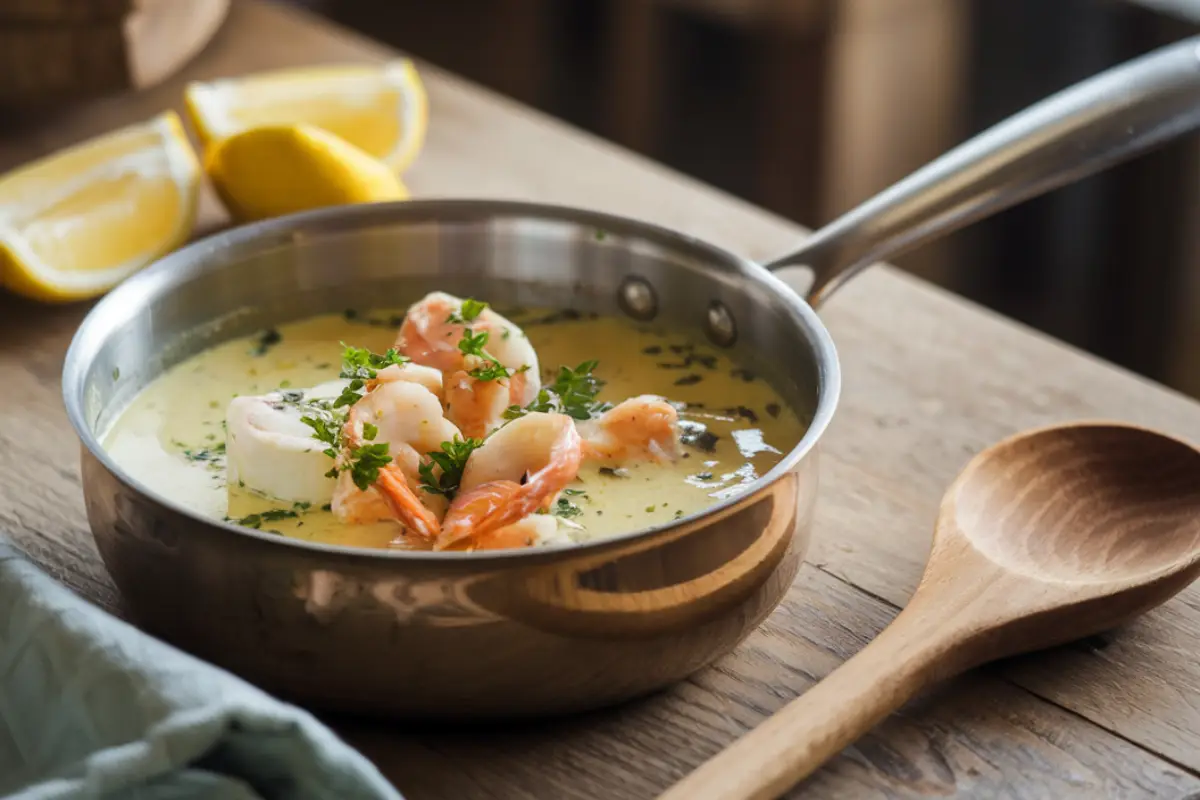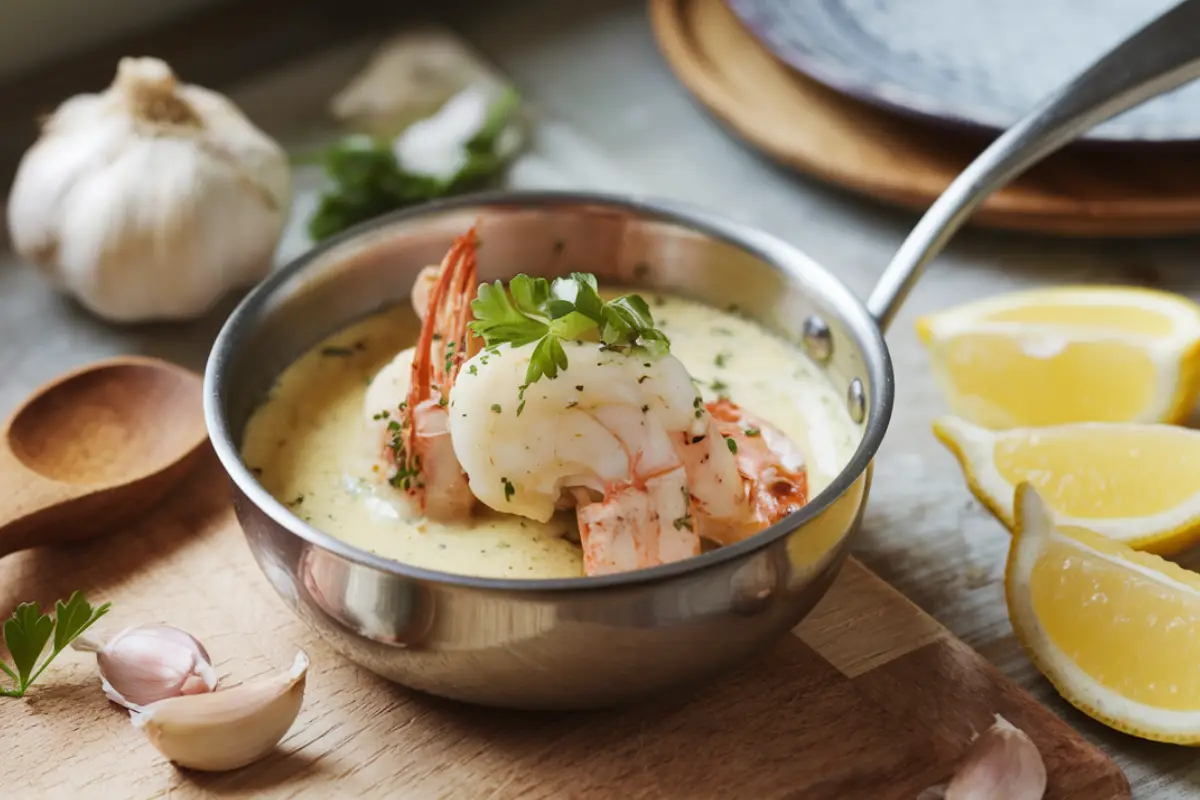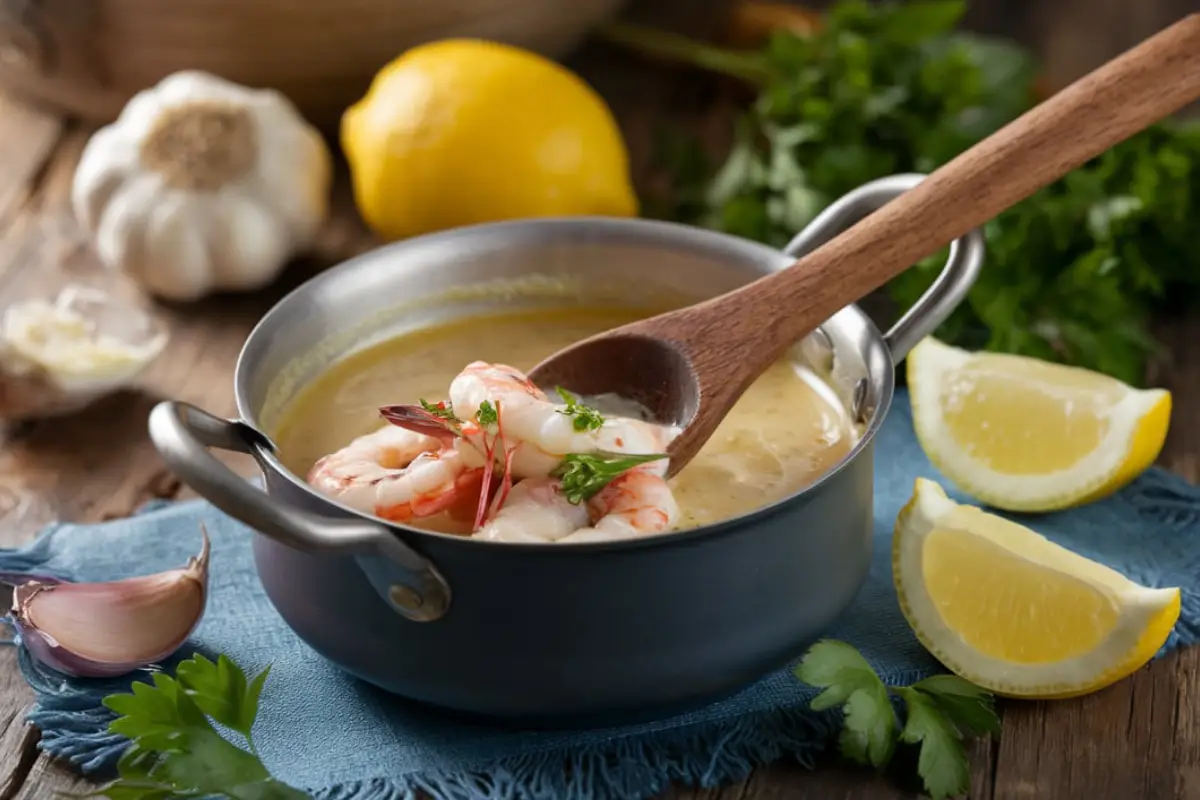Seafood butter sauce is a rich, creamy sauce that elevates seafood dishes with its buttery texture and bold flavors. Made with key ingredients like butter, garlic, lemon, and a blend of herbs and spices, this versatile sauce is perfect for shrimp, lobster, crab, and fish. It adds a savory depth and a touch of spice, making it an essential addition to seafood boils, grilled dishes, and even as a dipping sauce.
What makes seafood butter sauce truly special is its adaptability. You can tweak it to suit your taste—whether that means adding extra heat, a bit of sweetness, or adjusting the acidity. For a great example, try pairing it with Argentine Shrimp with Linguine, where the buttery sauce perfectly complements the shrimp’s flavor.
Key Ingredients of Seafood Butter Sauce
Creating a delicious seafood butter sauce is all about using simple yet impactful ingredients. Each one plays a crucial role in building the sauce’s flavor:
-
Butter: This is the base of the sauce, giving it a rich, smooth texture. Use unsalted butter to control the saltiness, or use salted if you adjust the seasoning. You can also brown the butter slightly for a deeper, nutty flavor—just be careful not to burn it.
-
Garlic: Fresh garlic adds an aromatic punch that pairs beautifully with seafood. You can use minced garlic for a strong flavor or roast the garlic first for a sweeter, more mellow taste.
-
Lemon Juice and Lemon Pepper Seasoning: These ingredients add a zesty kick that balances the richness of the butter. Freshly squeezed lemon juice is preferred for its bright flavor, and lemon pepper seasoning adds a mild peppery note.
-
Old Bay Seasoning: A classic choice for seafood, Old Bay seasoning combines celery salt, paprika, and black pepper to add a savory, slightly spicy flavor that enhances seafood dishes.
-
Cayenne Pepper and Smoked Paprika: These spices bring warmth and a touch of smokiness, creating a mildly spicy undertone. You can adjust the cayenne to your liking for more or less heat.
-
Honey or Sweeteners: A hint of honey or a sweetener like maple syrup balances the savory and tangy elements of the sauce, making it well-rounded and versatile.
For another example of how this sauce can enhance your seafood, try the Seafood Boil Sauce Recipe for an adaptable and flavorful experience.
How to Make Seafood Butter Sauce
Making seafood butter sauce is quick and easy, and the results are always impressive. Here’s how to do it:
-
Melt the Butter: In a large skillet, melt the butter over medium-low heat. This gentle heat helps keep the butter smooth and prevents it from burning.
-
Sauté Garlic and Onion: Add minced garlic and a bit of finely chopped onion, cooking gently for 2-3 minutes until they’re softened. This step infuses the butter with a rich, aromatic base. Be careful not to brown the garlic, as this can make the sauce bitter.
-
Add Seasonings: Stir in Old Bay seasoning, cayenne pepper, smoked paprika, and lemon pepper seasoning. Let the spices cook for another 2-3 minutes to release their flavors into the butter.
-
Finish with Lemon Juice and Sweetener: Add freshly squeezed lemon juice and a tablespoon of honey or your preferred sweetener. Stir everything together and taste—add more lemon juice for brightness, more honey for sweetness, or salt for balance.
- Serve Immediately: Remove from the heat and serve warm with your favorite seafood. This sauce is perfect over steamed shrimp, grilled fish, or as a dipping sauce for crab legs. It’s also great drizzled over vegetables or mixed into pasta.
Expert Tips for Perfect Seafood Butter Sauce

Here are some helpful tips to make sure your seafood butter sauce turns out perfectly every time:
-
Keep the Heat Low: Butter burns easily, so always melt it over medium-low heat. This keeps the sauce smooth and prevents unwanted bitterness.
-
Balance the Flavors: If the sauce tastes too rich, add more lemon juice to cut through the fat. If it’s too tangy, a bit more honey can help smooth it out.
-
Adjust the Spice: Add extra cayenne pepper or red pepper flakes for more heat, or reduce these if you prefer a milder sauce.
-
Use Fresh Ingredients: Fresh garlic and lemon juice offer the best flavor. Pre-packaged alternatives can be used, but they might not deliver the same vibrant taste.
-
Experiment with Aromatics: For added depth, try infusing the butter with shallots, thyme, or rosemary before adding the main ingredients.
Variations and Customizations
Seafood butter sauce is highly customizable. Here are some popular variations:
-
Spicy Cajun Butter Sauce: Swap Old Bay seasoning for Cajun seasoning, which includes garlic powder, onion powder, and cayenne. This version adds extra spice, perfect for grilled shrimp or crab.
-
Garlic Herb Butter Sauce: Add fresh herbs like parsley, dill, or thyme to bring a burst of freshness to the sauce. This works especially well with baked or grilled fish.
-
Lemon Garlic Butter Sauce: Increase the lemon juice and add fresh lemon zest for a brighter, citrus-forward sauce. This variation is great with delicate fish, scallops, or chicken.
-
Creamy Butter Sauce: Add a splash of heavy cream to create a rich, velvety texture that’s ideal for pasta dishes like linguine or fettuccine.
-
Wine-Infused Butter Sauce: Incorporate a splash of dry white wine, such as Sauvignon Blanc or Chardonnay, to add subtle acidity and depth. Let the wine cook down slightly before adding the other seasonings.
-
Asian-Inspired Butter Sauce: For a twist, add soy sauce, ginger, and a bit of sesame oil. This creates an umami-rich flavor that pairs well with shrimp or scallops and makes a great dipping sauce for dumplings.
Storing and Reheating Seafood Butter Sauce
Seafood butter sauce is easy to store and reheat, making it great for meal prep:
-
Refrigeration: Store in an airtight container in the fridge for up to one week. Reheat gently on the stovetop over low heat, stirring occasionally.
-
Freezing: Freeze in a freezer-safe container for up to six months. Thaw in the refrigerator overnight before reheating.
-
Reheating Tips: Reheat slowly on the stovetop and stir frequently. If the sauce thickens too much, thin it with a bit of water, broth, or lemon juice.
FAQs
What seafood pairs best with butter sauce?
This sauce is incredibly versatile and works well with shrimp, crab, lobster, scallops, and white fish like cod or halibut. It’s also great as a dipping sauce for crusty bread or drizzled over roasted vegetables.
Can I make seafood butter sauce ahead of time?
Yes, this sauce can be made ahead and stored in the refrigerator or freezer. It’s a great way to save time, especially when hosting or preparing a big meal.
How can I make a healthier version of seafood butter sauce?
For a lighter option, use half butter and replace the rest with olive oil or vegetable broth. You can also use plant-based butter alternatives to reduce calories and make the sauce vegan-friendly.
Is seafood butter sauce suitable for dietary restrictions?
The sauce is naturally gluten-free and can be made dairy-free with vegan butter substitutes. Always check the labels on seasonings to ensure they are free from hidden allergens.
Can I add different flavors to the sauce?
Absolutely! You can get creative with additions like capers, sun-dried tomatoes, or anchovy paste for a Mediterranean touch. Adding spices like turmeric or cumin can also create unique flavor profiles.
Can I use the sauce in non-seafood dishes?
Yes! This sauce is delicious over grilled chicken, mixed into mashed potatoes, or tossed with roasted vegetables, making it a versatile addition to any meal.
Nutritional Information and Considerations
Seafood butter sauce is indulgent and rich, primarily due to its high butter content. A typical serving of this sauce contains around 30-50 calories, but the exact nutritional values can vary depending on the specific ingredients and portion sizes used. Here’s a deeper dive into the nutritional aspects and considerations for those mindful of their dietary intake:
-
Caloric Content: The primary source of calories in seafood butter sauce comes from butter, which is rich in fats. Each tablespoon of butter contributes approximately 100 calories, with most of these calories coming from saturated fat. For those watching their calorie intake, you can reduce the amount of butter used or opt for a blend of butter and a lighter alternative like olive oil to lower the overall calorie count without sacrificing too much flavor.
-
Fat Content: Butter is high in both saturated and unsaturated fats. Saturated fats, while adding to the sauce’s creamy texture, can contribute to higher cholesterol levels if consumed in excess. To make the sauce healthier, consider using half the amount of butter and replacing the rest with olive oil, which contains heart-healthy monounsaturated fats. Alternatively, you can use plant-based butter substitutes that are lower in saturated fats and offer similar texture and flavor.
-
Sodium Levels: Depending on the type of seasonings used, particularly Old Bay or Cajun seasoning, the sauce can be relatively high in sodium. For those monitoring their sodium intake, it’s important to use low-sodium versions of these seasonings or adjust the amount of added salt. You can also enhance flavor with herbs and spices rather than relying heavily on salt-based seasonings.
-
Carbohydrates and Sugars: Seafood butter sauce generally contains very low carbohydrates, making it suitable for low-carb and keto diets. The small amount of carbohydrates present usually comes from garlic, onion, and any sweeteners like honey or maple syrup. If you prefer to reduce sugars, you can omit sweeteners entirely or use a sugar substitute that aligns with your dietary needs.
-
Protein Content: The sauce itself is not a significant source of protein. However, when paired with high-protein seafood like shrimp, crab, or fish, it complements a protein-rich meal, making it ideal for those looking to increase their protein intake without adding excessive carbs or sugars.
-
Vitamin and Mineral Content: The lemon juice in the sauce adds a small boost of vitamin C, which supports immune function and offers antioxidant benefits. Garlic, known for its potential heart health benefits, also provides trace amounts of vitamins and minerals such as manganese and vitamin B6. If you add herbs like parsley or dill, you can also enhance the sauce’s vitamin content slightly.
-
Dairy-Free Alternatives: For those with lactose intolerance or dairy allergies, using vegan butter substitutes can make this sauce suitable for a wider range of diets. These alternatives often use ingredients like coconut oil, cashews, or olive oil to mimic the texture and flavor of butter without the dairy content.
-
Gluten-Free: Seafood butter sauce is naturally gluten-free, making it a safe choice for those with celiac disease or gluten sensitivity. Just be sure to double-check all seasonings and flavorings for any hidden gluten, especially in pre-mixed seasonings.
-
Adjusting for Special Diets: Whether you are following a keto, paleo, or plant-based diet, seafood butter sauce can be easily adapted. For a keto-friendly version, keep the butter and adjust seasonings to avoid added sugars. For a paleo approach, use ghee instead of butter and avoid processed sweeteners. For plant-based diets, replace the butter with a vegan substitute and ensure all seasonings are free of animal-derived products.
-
Portion Control: Given its richness, it’s easy to go overboard with seafood butter sauce. Moderation is key, especially for those watching their fat and calorie intake. A little goes a long way in flavoring seafood dishes, so start with smaller servings and add more as needed.
Health-Conscious Modifications

If you’re looking to make your seafood butter sauce healthier, consider these modifications:
-
Reduce Butter and Add Broth: Cutting down on the butter and replacing part of it with seafood or vegetable broth can lower the calorie and fat content while maintaining the sauce’s savory flavor.
-
Increase Fresh Herbs and Spices: Rely more on herbs and spices for flavor rather than butter and salt. Fresh parsley, dill, or thyme can enhance the taste while adding minimal calories.
-
Use Lemon Zest for Extra Flavor: Adding lemon zest can intensify the citrus notes without adding any calories, helping to brighten the sauce and make it feel lighter.
-
Experiment with Light Dairy Alternatives: If you want to make the sauce creamier without adding too much fat, consider using light cream, half-and-half, or even Greek yogurt as a partial replacement for butter.
Conclusion
Understanding the nutritional profile of seafood butter sauce allows you to make informed choices that fit your dietary needs. Whether you’re looking to indulge or seeking healthier adaptations, this sauce offers a flexible base that can be modified to suit various nutritional goals. Its richness, flavor, and versatility make it a beloved addition to seafood dishes, and with a few mindful adjustments, you can enjoy it as part of a balanced diet.

